The Concept Art of Star Wars™ Battlefront™ II
Enjoy some stunning concept art and learn more about its role in bringing the levels in Star Wars™ Battlefront II to life.

At DICE, we take a lot of pride in the visuals going into our games. Of course, tech contributes a lot with Frostbite being a powerful game engine, but the high level of visual fidelity wouldn’t be possible without a collaborative effort, spanning talent across different fields.
In Star Wars™ Battlefront™ II, a stellar-looking environment is never down to just a couple of artists, but rather to different crafts working together as a team. That’s the only way we can achieve the standards we set for our games.
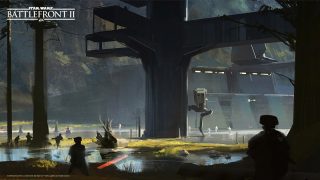
Explorational concept art of the Imperial Base on Endor in Star Wars Battlefront II.
Below, however, we’re going to take a closer look at the role of concept art specifically. By showcasing some work, and walking you through the process, we hope to give you a better understanding of its function and importance. But, admittedly, we also just want to show off some stunning Star Wars™ art.
So, we’ll give you both!
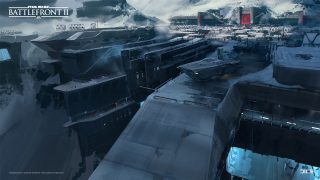
Starkiller Base.
The Idea and First Draft
It always starts with the idea. The concept artists get together to brainstorm the setting, the mood, and what characters and creatures should inhabit this space. They’re not only working to match the movie references, but they’re also figuring out how to tell the narrative in a visually clear and authentic way together with the story team and Lucasfilm. Quick thumbnails are sketched out and discussed.
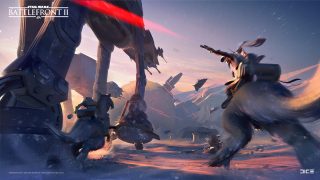
Tauntauns on Hoth.
Once the initial idea is on paper, the process of fleshing it out begins. It’s common practice to block out the environment using 3D software such as Maya, or whatever program the artist is most comfortable with. Although artists have different backgrounds, trainings, and personal styles, their work ultimately contributes to the same goal.
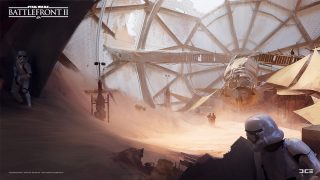
First Order forces on Jakku.
The 3D block out acts as a base for perspective, scale, and a rough, initial lighting pass. This method makes it a lot easier for the artist to create complex environments quickly, as opposed to more traditional, more manual methods, like using a perspective grid.
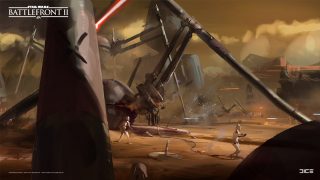
The battle on Geonosis rages on.
Once the block out is made, the image is rendered, brought into Photoshop, and painted on top of. To capture the right mood, artists might use color palettes from existing material from the movies, or other reference materials provided by Lucasfilm.
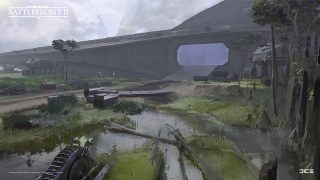
Venator-class Star Destroyer on Kashyyyk.
Different Categories of Concept Art
Most art in this article feature environmental and visual effects, lighting, and lots of details, making up images that resemble a final look. Not all concept art appears that way, though. There are different kinds, serving different purposes. Take this image of a section of the Death Star II, for example.
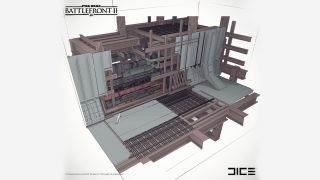
A section of the Death Star II being constructed.
The intent of this image is to show how a piece of the Death Star II could look like while it’s being constructed. This type of concept art acts as a guide for the 3D artists – the people who are going to build these structures and objects – so they can get a clear, unobstructed view of the geometry.
By directly comparing this layout image to the art down below – one featuring atmospheric lighting, reflections, steam coming out of the floor, and generally representing a more final look – you’ll be able to see why the above is more useful for a 3D artist at an early building stage.
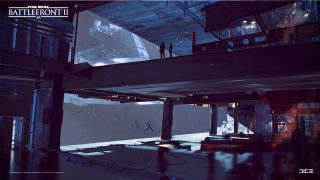
Death Star II concept art representing a more final look.
Now, this overview line drawing of the space dock on Mos Eisley serves yet another purpose.
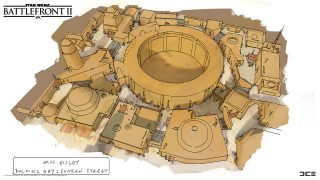
A birds-eye view of the space dock in Mos Eisley.
This is to inform the level designers – who probably have their rough building blocks laid out at this point – and the environmental artists how to exactly configure these buildings to make them look and feel like a real, alive, and breathing city.
It provides them with a view of how we should space these buildings out – and how much surrounding prop dressing is needed – to make it look believable.

Clearing out the Rebel scum from the dusty streets of Mos Eisley.
The layout view of Death Star II, and the overview of Mos Eisley, also act as material which the art team can center discussions around with Lucasfilm, to make sure that we’re set on the right course.
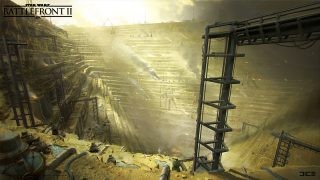
The Coaxium Mines of Kessel in Star Wars Battlefront II.
Applying the Star Wars Legacy to a Multiplayer Action Game
As you might expect, there are lots of things to take into account when creating new art for Star Wars, a universe filled with such a rich visual and narrative history.

The lush forests of Takodana, inspired by Star Wars: Episode VII – The Force Awakens™.
The legacy of Star Wars needs to be treated with care. We can’t wander off and create something that has a completely different look and feel. Because then it simply wouldn’t be Star Wars. Our close relation with Lucasfilm is key to make sure we check all the boxes here.
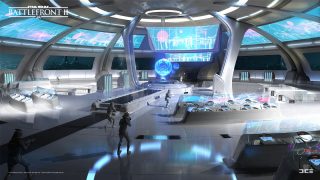
Clone troopers in the Cloning Facility on Kamino.
Before creating the concept of the Cloning Facility on Kamino, for example, the artist closely studies what’s been previously created. That knowledge is then used to create an interpretation which would work within the given gameplay limitations.
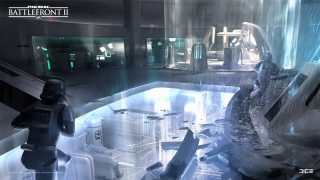
Another area concepted for the Cloning Facility on Kamino.
A 1:1 representation of Kamino as seen in the movie might not necessarily make up a great multiplayer map. Same goes for every other location that we bring to the game.
The spaces we see in the reference material might be too big, or too small, to function in the game. More places for players to hide and take cover may be needed, so it doesn’t become a sniper fest. And so forth.
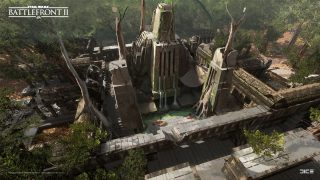
The ancient temple grounds on Yavin 4.
Ultimately, our mission is to marry a universe that millions of Star Wars fans hold dear with fun gameplay.
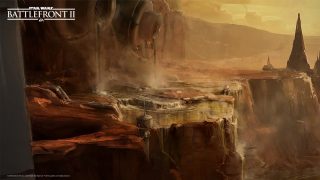
Toxic factory waste on the barren Geonosian home world.
Concept Art is Intertwined Throughout the Development Process
Concept art is important as it helps to visualize and bring out ideas in the advent of a game’s creation. However, at DICE, the concept art team is intertwined throughout the entire creation process for the levels in the game.
Things don’t just change between the movie references and the initial concept art, but also between initial concept art and level design.
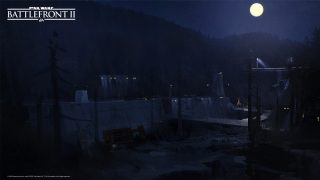
Night on Endor.
Once the level designers have blocked things out, the concept artists usually must have another pass at the architectural details, simply because the play area has changed.
Let’s say that a courtyard in a building space is a certain size in the concept, but once we get the characters in there to run around in early playtests, we realize that it needs to be a lot smaller.
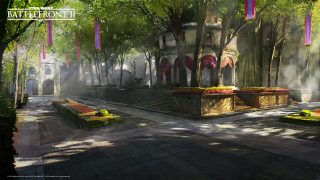
The serene beauty of Theed.
As the level creation progresses, concept art is continuously used to flesh out ideas and bring in more details where needed.
Also, the initial concept art only portrays a small selection of areas in the level – not its entirety. When level designers add more areas to the map, concept artists are brought in to improve upon those with paint overs showing lighting and visual effects, re-applying the same esthetics from previous concept images.
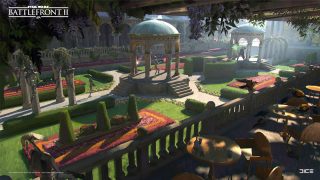
Another area in the royal capitol of Naboo.
This continuous effort is all about bringing the current state of the map closer to the initial concepts. At first, concept art works as a guide to what to create. But as we start getting things into place, it also serves as a standard to push the quality even further.
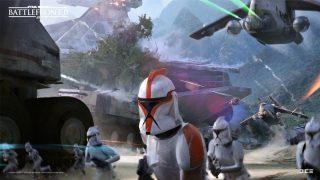
Clone troopers rushing to defend Kashyyyk from the Separatist army.
Which brings us to another important point: concept art acts as an aspirational goal, or vision, of how we want the game to look.
Its goal is to show how a rough, blocked out level could look once we have the finished lighting, atmospherics, and textures. How it could look if we add certain details such as extra trees, hanging banners, and other niceties.
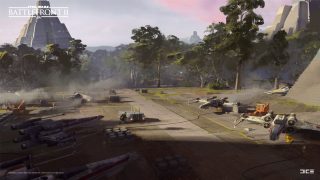
X-wings stationed on the grounds outside the Great Temple on Yavin 4.
And, to show that if we make it to this level of quality in the game, we’re in a good place.
Then the environment artists, lighters, and visual effect artists can drive it to a point where it looks close to the concept art – if not better!
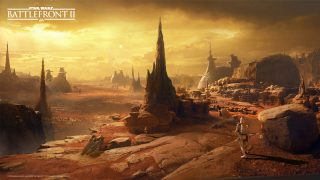
The Clone Wars have begun with the arrival of Geonosis to Star Wars Battlefront II.
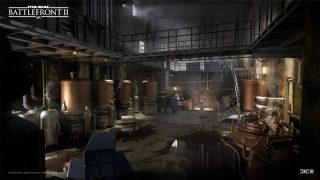
The brewery in Maz’s Castle on Takodana.
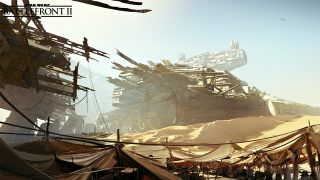
The downed Star Destroyer on Jakku.
–Daniel Steinholtz (Follow Daniel on Twitter @dsteinholtz)
Remember to keep an eye on this space for full coverage of Star Wars Battlefront II. Also, sign up today to receive the latest Star Wars Battlefront II news, updates, behind-the-scenes content, exclusive offers, and more (including other EA news, products, events, and promotions) by email, and be sure to follow EA Star Wars on Twitter, Facebook, and Instagram, or join the discussion on the official forums.


